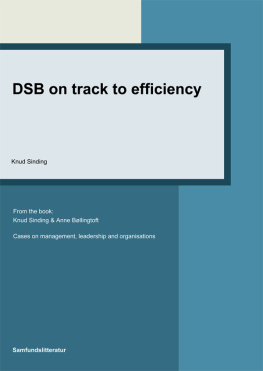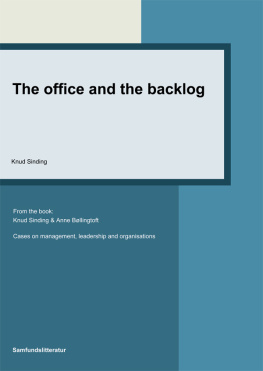Sinding - DSB on track to efficiency Cases on Management, Leadership and Organisations
Here you can read online Sinding - DSB on track to efficiency Cases on Management, Leadership and Organisations full text of the book (entire story) in english for free. Download pdf and epub, get meaning, cover and reviews about this ebook. City: Samfundslitteratur, year: 2013, publisher: Samfundlitteratur;Knud Sinding, Samfundslitteratur, genre: Romance novel. Description of the work, (preface) as well as reviews are available. Best literature library LitArk.com created for fans of good reading and offers a wide selection of genres:
Romance novel
Science fiction
Adventure
Detective
Science
History
Home and family
Prose
Art
Politics
Computer
Non-fiction
Religion
Business
Children
Humor
Choose a favorite category and find really read worthwhile books. Enjoy immersion in the world of imagination, feel the emotions of the characters or learn something new for yourself, make an fascinating discovery.
- Book:DSB on track to efficiency Cases on Management, Leadership and Organisations
- Author:
- Publisher:Samfundlitteratur;Knud Sinding, Samfundslitteratur
- Genre:
- Year:2013
- City:Samfundslitteratur
- Rating:4 / 5
- Favourites:Add to favourites
- Your mark:
- 80
- 1
- 2
- 3
- 4
- 5
DSB on track to efficiency Cases on Management, Leadership and Organisations: summary, description and annotation
We offer to read an annotation, description, summary or preface (depends on what the author of the book "DSB on track to efficiency Cases on Management, Leadership and Organisations" wrote himself). If you haven't found the necessary information about the book — write in the comments, we will try to find it.
DSB on track to efficiency Cases on Management, Leadership and Organisations — read online for free the complete book (whole text) full work
Below is the text of the book, divided by pages. System saving the place of the last page read, allows you to conveniently read the book "DSB on track to efficiency Cases on Management, Leadership and Organisations" online for free, without having to search again every time where you left off. Put a bookmark, and you can go to the page where you finished reading at any time.
Font size:
Interval:
Bookmark:
Knud Sinding
DSB on track to efficiency

Knud Sinding
DSB on track to efficiency
From the book:
Knud Sinding and Anne Bllingtoft
Cases on Management, Leadership and Organisations, 1st edition 2012, chapter 21
1st e-book chapter 2013
Samfundslitteratur 2012
Cover design: Klahr|Graphic Design
Typeset: SL grafik, Frederiksberg
E-book production: Rosendahls BookPartnerMedia
ISBN: 978-87-593-9522-6
Samfundslitteratur
Rosenoerns All 9
DK-1970 Frederiksberg C
Denmark
Tlf: + 45 38 15 38 80
Fax: + 45 35 35 78 22
www.samfundslitteratur.dk
All rights reserved.
No part of this publication may be reproduced or used in any form or by any means graphic, electronic or mechanical including photocopying, recording, taping or information storage or retrieval system without permission in writing from the publisher.
CHAPTER 21
DSB ON TRACK TO EFFICIENCY
De Sover Bare (Danish for: They are just sleeping) is just one of the many wittycisms about what the letters DSB stand for (officially DSB stands for the Danish State Railways). The large governmental entity has often been criticised, except for short periods during which results, innovation and new thinking have set the agenda.
DSB has almost always been surrounded by scandals or at least by political disagreements. This was true when the public railways were first created in 1884, and it is true of the present. After 2000, controversy has been centred on the much-delayed delivery of new trains from the Italian company Ansaldo Breda.
A brief history of DSB
The public railways havent always been publicly owned. The first railways were built by British contractors, but as the development of the rail network accelerated in the 1860s and 1870s, the state became increasingly involved, first as financial guarantor and later as the full owner and developer. The public railways were finally established in 1884 (but did not include all railways in the country). Until the beginning of the 1960s the network stayed much the same, but as the use of automobiles for transport of people and freight increased, more and more lines became redundant and were closed. Over time, many technical revolutions have disrupted the status quo in DSB. The diesel engine replaced the steam engine from the 1930s; bridges were built and ferries scrapped; locomotives were replaced by train sets (from the 1930s and especially from the 1990s); electricity replaced diesel as an energy source on a small portion of the network, between Helsingr and Padborg. Last but not least, DSB lost ownership of the infrastructure (which was transferred to BaneDanmark) and its monopoly of the use of the railways (firstly to the British company, Arriva, but it was then later bought by the German State Railways or DB).
The years 2009-2010 were a turbulent time for DSB. The much delayed IC4- and IC2-train sets were one of the difficult challenges facing DSB, but major economic problems with the subsidiary, DSB First, which handled rail traffic from Helsingr via Copenhagen to a number of cities in Southern Sweden, contributed to the turmoil. It culminated in March 2011 when the board of DSB chose to dismiss CEO Sren Eriksen. Shortly thereafter, Chairman Mogens Granborg resigned due to health reasons. During the summer of 2011, DSB appointed a new CEO, Christian Roslev, who handed in his resignation less than three months later. The reason was stated as being health problems. In mid December 2011, DSB announced that Jesper T. Lok, from the shipping company Svitzer, would become the new CEO by July 1st, 2012 at the very latest.
These events look pretty dramatic. They were probably much more dramatic on the inside, but little has changed regarding these events. The report about the possibilities for improving the financial performance of DSB, and on which this case is based, gave rise to some public controversy, especially as the chairman of the Danish Railway Association (the rail workers union) Ulrik Salmonsen foresaw the permanent end of railway operations in Denmark. Salmonsens reaction was not strange, as a large part of the report dealt with the issue that his members would have to work more for less pay as well as be presented with fewer jobs.
The report dealt with three main areas: The train services and the associated personnel, the purchase of goods and services, and DSBs administrative functions. In all three areas, DSBs use of resources was compared to that of other, similar organisations and the spending levels of these. In practice, this meant other railway companies and other public organisations.
Train crews
The days when trains were pulled by steam locomotives and were manned by drivers, firemen, train guards, ticket inspectors and maybe a parcels clerk for handling luggage etc. has long since given way to modern practices. Even though the majority of DSBs trains arent pulled by locomotives, there is still a driver and there is still a train guard who checks tickets, ensures that departures from the stations happen safely, and generally services the passengers, but apart from that, a steward who sells refreshments on the train is the only other staff. There can be extra personnel on the train (on long and crowded trains), and train stewards personnel also have certain safety functions.
In a detailed breakdown of the activities, a driver, whose normal work year consists of 1924 hours, the report demonstrated that only 407 hours were spent sitting in the cab of the train and driving it from station to station. This corresponds to 1 hours a day on average. Even if time shunting and getting the train ready were included, the average, daily working time doesnt exceed 2 hours. The report explains that this low number is due to overcapacity (too many drivers), poor work organisation and rigid work time regulations.
The report claims to show, through a comparison with other train operators in Europe, that this is a rather low amount of effective working time, even after taking into account irregular working hours, vacation and illness. On this basis, it is concluded that DSBs locomotive drivers only work half the time of what they could (about 750 hours annually is reported to be good practice in Europe). The effective working time is higher for S-train (the sub-train system in Copenhagen) drivers and train guards, but there is also room for improvement here. For crews, the single largest savings option is replacing most train guards with technology (video surveillance, etc.) combined with random checks by ticket inspectors. Here, the savings are estimated to be about 230 million Danish Kroner annually.
The low effective working hours could perhaps, partly, be expected to be offset by relatively low wages, but the opposite is true. There are no comparable job categories, but for lack of something better, the report compares DSBs wages to bus drivers salaries. Compared to these salaries, locomotive drivers earn 1 times (48%) more. Comparing train guards to semi-skilled workers in the state sector shows a difference of 53% (the most specialised training a train guard receives is a comprehensive safety course known as SR. This and other courses take 6 months to complete in all). The report presents two major ways of saving on wages; partly by a reduction of fixed allowances, and partly by a general reduction of the salary of newly hired train crew of 20%. With complete implementation, these measures would allegedly save 270 million Danish Kroner annually.
A particularly large cost item for trains is the onboard refreshment service. The refreshment stewards and their sales carts are a thumping deficit-generating business. The annual net cost of maintaining the services is 135 million Danish Kroner, of which much of it is constitutes wages (230 full-time equivalents). The report envisions that the refreshments service could be replaced by vending machines on the trains.
Next pageFont size:
Interval:
Bookmark:
Similar books «DSB on track to efficiency Cases on Management, Leadership and Organisations»
Look at similar books to DSB on track to efficiency Cases on Management, Leadership and Organisations. We have selected literature similar in name and meaning in the hope of providing readers with more options to find new, interesting, not yet read works.
Discussion, reviews of the book DSB on track to efficiency Cases on Management, Leadership and Organisations and just readers' own opinions. Leave your comments, write what you think about the work, its meaning or the main characters. Specify what exactly you liked and what you didn't like, and why you think so.













